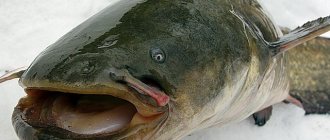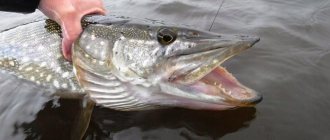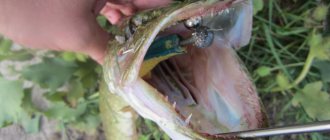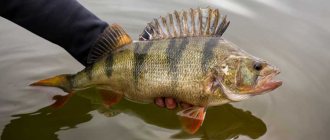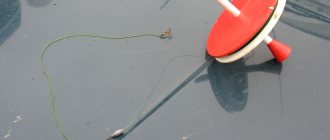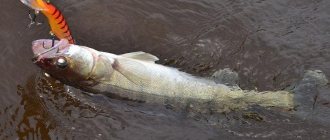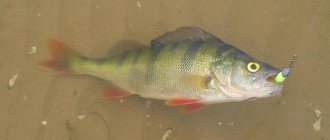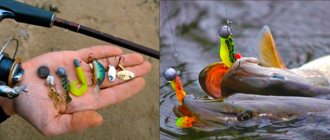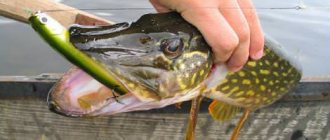Jig fishing for pike deserves special attention among the methods of hunting for predators due to its prey ability and simple technique for performing fishing techniques. An important factor in the popularization of jig was the variety of inexpensive, but at the same time effective baits used in this fishing method. Spinning for jig fishing for pike is a mandatory attribute of every fishing store, and as you know, availability generates interest and development, which influences the continued successful spread of jig in the fishing culture of predator fishing. Our next article will be about the secrets of jig fishing for pike.
Rules for choosing the right jig head
Fishing for pike on a jig is not complete without the use of weights, which are sinkers specialized for the fishing method, called jig heads. Heads are available in several variations of their shapes, each of which satisfies one or another hunting conditions. The most familiar to spinning players are stationary jig heads in the form of a lead ball with a hook soldered into the body, which are considered universal in jigs. But in addition to the ball, for better maneuverability of the bait, the shape of a boot can be used. In addition to stationary jig heads, manufacturers produce articulated weights or cheburashkas, which hinder the movement of rigs less and make the bait more mobile and more natural when retrieved. Hinged weights are also produced in the form of a bullet. These loads increase the range of the tackle.
Features of catching pike with jig from the shore, boat and at night
Both from the shore and from a boat, jig fishing tactics boil down to fishing promising places.
Catching pike with a jig from a boat in the fall is many times more promising, as it allows you to fish at any point in the reservoir. And the presence of an echo sounder significantly increases the possibilities for a spinning boater.
Video: coastal pike fishing with jig in autumn
Shore fishing is less promising, as it requires the fisherman to cover long distances along the coast. It’s not for nothing that they say “the legs feed the wolf” - this is precisely the case of shore jig.
With both boat and shore fishing, success is guaranteed if promising places are known that have previously yielded catches.
Video: Catching pike with a jig in the fall from a boat
Many anglers fish with jigs at night . By attaching a firefly to the tip of the rod, you can effectively control the wiring and track bites.
By the way!
In addition to the gear itself and a set of baits, there is one more device necessary for an autumn jig spinner - a
hook . It is almost impossible to drag a trophy toothy predator into a boat without a hook.
Installation of equipment for catching pike with a jig
Preparation for catching predators with a jig begins with assembling and completing the equipment. The equipment is not complicated and includes standard elements selected for the weight of the baits used.
Important! It is worth paying attention to the choice of lightweight equipment, since jig fishing is one of the most dynamic methods of spinning fishing, and heavy tackle will not allow the angler to conduct even a couple of hours of high-quality and intensive casting fishing.
The kit itself consists of a spinning rod, a spinning reel, a cord and a bait combined with a jig head. We’ll talk more specifically about the parameters of each component in the continuation of our material.
Selecting a spinning rod, reel, hook and line
For jigging, semi-fast spinning rods are selected in lengths for coastal fishing from 2.3-2.7 meters and fishing from boats from 1.7 to 2.1 meters. Test parameters in pike fishing vary from 4 to 20 grams, which corresponds to the parameters of light and, occasionally, ultralight rods. The inertia-free mechanism must be distinguished by the reliability of the mechanism, because the main load of guiding and landing fish falls on this element of the equipment. Jig reels fit into the size selection parameters of 1500–3000 units, with a gear ratio of 1/5. You also need a friction clutch that allows you to adjust different loads from the resistance.
Important! For jig fishing, purely braided cords are used, which have a low stretch coefficient, which better transmits signals when animating the bait and biting the trophy.
Hooks are used based on the size of the bait. As a rule, these are hooks with an elongated shank. The fastening of the hook soldered into the head is located on the load. The hook used in hinged joints must have a fastening ring. The articulated jig head is mounted to the hook through just such a fastening ring. For non-hooking lures, offset hooks are used.

Important! A mandatory element of equipment when fishing for pike is a leash, which can be made of fluorocarbon line, steel or Kevlar.
The length of the leash varies from 15 to 30 cm, depending on the expected size of the trophy in the catch.
Pike fishing equipment
Several equipment options are common, depending on the load.
Equipment options
Rigid jig head mount. The method is the simplest. The jig head is connected to the bait so that the tip comes out from above the bait, and the weight is located in front of the bait.
Flexible mount. The peculiarity is that the weight is connected to the bait and hook using a winding ring. Offset hooks can be used in this equipment.
There are also different types of equipment:
- drop shot;
- diverter leash;
- Texas;
- Caroline;
- Tyrolean stick.
What is a jig-rig
One of the most common rigs is the jig-rig. This equipment was invented in the USA for catching bass. Now it is very successfully used for pike fishing. In the classic jig-rig rig, a hook with bait is attached to an elongated large sinker using two small winding rings. With this rig you can fish in the most difficult places without fear. The presence of a swivel joint contributes to good animation of the bait. The jig-rig flies well over long distances. The equipment is well suited for catching pike of any size.
Jig head size and weight
Methods for selecting the required bait weight depend on the fishing conditions and, in particular, the strength of the current and the depth of the reservoir. For fishing currents with the same bait, heavier loads are used than for fishing with the same bait in still waters. This is due to movement errors during wiring, which occur as a result of the resistance of the bait to the flow. Jig fishing is mostly carried out in the bottom layers of a reservoir, and for fishing in deep areas, the weight of jig heads is increased to speed up the delivery of equipment to the bottom of the reservoir. So, if you fish at a depth of three meters, then it is effective to use a mass of 8 grams, and if you fish with the same bait at 10 meters, then it is reasonable to increase the mass to 14–15 grams. In this case, the time of the bait falling to three-meter and ten-meter depths will be almost identical in time.
Equipment
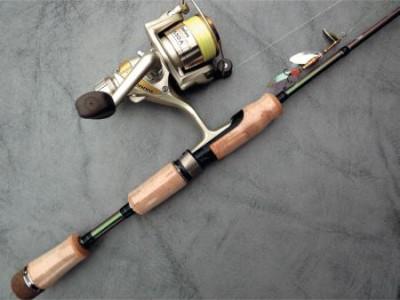
The length of the rod for jig bait depends on the fishing method:
- from the shore – 2.2 – 2.7 meters;
- from a boat – 1.7 – 2.1 meters.
If conditions are constantly changing, you should choose a universal size - from 2.1 to 2.4 meters . This value has proven itself well and is suitable even for novice fishermen. The main thing is that the other characteristics of the spinning rod match.
of a fishing rod is its response to load levels. Opinions differ about the optimal action for a jig spinning rod. It should be loud and sensitive. In fast current conditions, a Fast action with a cast of 15-40 g is appropriate. In difficult waters and when using heavy and large baits, choose a rod with an L-fast action and a cast of 20-56 g.
The manufacturer is not always important when choosing a spinning rod for jigging. Some companies offer a whole line of high-quality spinning rods; you can find what you need at a reasonable price.
The main requirement for a reel is the presence of a metal spool . This requirement is due to the use of braided cord. The clutch is front, although the rear is used with the same success. For a medium jig, a reel with a line capacity of up to 3000 Shimano is suitable.
The fishing line is suitable braided , with a diameter of at least 0.18 mm.
We recommend using fluorocarbon leashes with a length of 1 meter or more. Line diameter – 0.25-0.3 mm. It is invisible under water and stretches well. The windage of the material slows down its progress under water, and the slower the bait, the more it attracts a predator.
A leash twisted from string is considered reliable . Its diameter will be 0.17 mm, length 5 cm. It is mounted to a fluorocarbon piece. A jig is attached to the untwisted leash and twisted again.
Jig lures for pike
Classic jig baits for pike are, of course, made of silicone, although foam rubber baits and rotating spoons are also suitable for these purposes. It is impossible to unambiguously name the best bait option, because the preferences of the toothy bait are changeable, and the wiring technique of each spinning player, despite the common principles, differs in the nuances of execution. Therefore, only practice of wiring with development of their technique and experimentation in the use of different types of attachments can bring the expected result.
Silicone baits
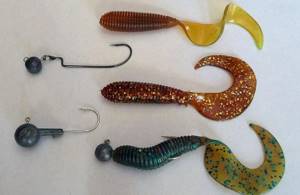
Silicone baits come in a variety of shapes and colors. For pike fishing, the optimal sizes are considered to be silicone sizes starting from 80 mm. Smaller items also attract interest from fish, but the caught specimens will not differ in their significant size. Both inert and soft playing silicone are suitable for jigging.
Important! The use of edible rubber increases the number of bites.
In fishing, vibrating tails and twisters are preferable, although all kinds of slugs should also not be excluded from fishing strategies, especially if the bite is not stable and requires non-standard moves when fishing.
Foam rubber baits
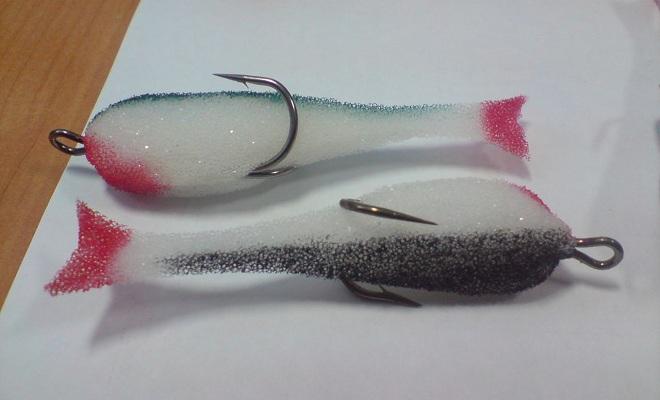
Foam rubber is one of the cheapest types of bait. When the predator is highly active, the inertia of the bait does not particularly affect the result, but frequent losses in the writhing of more expensive rubber can upset the spinner, which is not the case with foam rubber, which you can cut yourself and paint with markers in promising colors from waste construction materials. For pike, shapes starting from 10 cm and thicknesses of 20–25 mm are suitable.
Spinners
Rotating spoons on wire frames with front loading are also successfully used in jig fishing. For pike jigs, select products with oblong petals, the working angle of which is within 45 degrees. Jig baits for large pike of this type are taken in numbers 3–5 according to the Meps classification. The only drawback of fishing with this tool is the depth, which should not exceed three meters.
Choosing a jig head and bait for autumn pike fishing
Silicone and foam fish are equipped with a jig head or a Cheburashka weight with a hook.
The weight of the bait should be selected in such a way that after 2-3 turns of the reel the bait falls to the bottom in about 5 seconds. When biting passively, it is advisable to reduce the weight of the bait, and the game will be smoother.
There is an absolutely opposite technique - the weight of the bait is specially increased so that when it falls, it falls to the bottom with great force and creates a cloud of turbidity. When fishing for pike with silicone in the fall in snags, it is absolutely justified to use a bullet-type head weight.
Today's selection of jig baits is so diverse that silicone for pike in the fall can be chosen to suit every taste.
In jig fishing, using vibrating tails for pike in the fall is the most promising option. This bait is a soft and flexible fish. The length of such a silicone fish should be about 10 cm. It is not advisable to use smaller baits, since we expect to catch hungry and large specimens. And in late autumn, in the vicinity of the pits, you can use silicone fish baits up to 20 cm long.
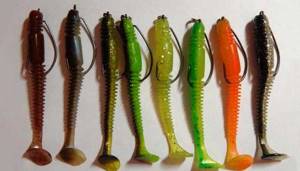
Today, edible silicone has appeared on the market in a wide variety of colors.
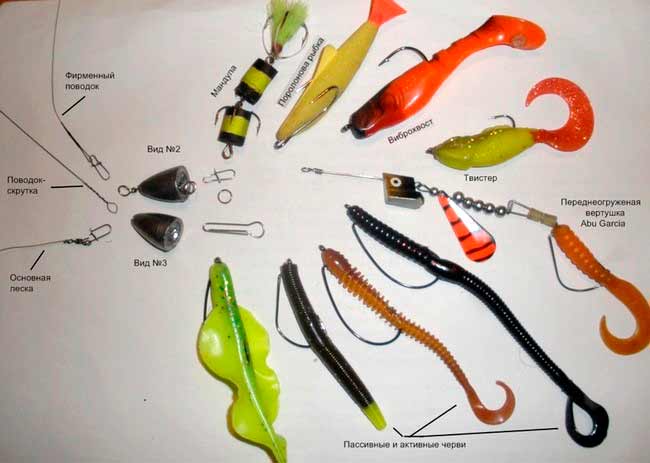
Another rubber option for pike in the fall is a twister. This is an excellent option for fishing in heavy snags, complete with an offset hook, which is hidden in the body of the bait.
In addition to the offset hook, the twister can also be equipped with a tee or double. Twisters without flavors are rarely found today, and the market offers a wide range of different flavors. In the fall, a rubber band for pike can be equipped with noise chambers and create a rattle effect when playing. The body of the twister can be decorated with pieces of thread or pierced with silicone slices.
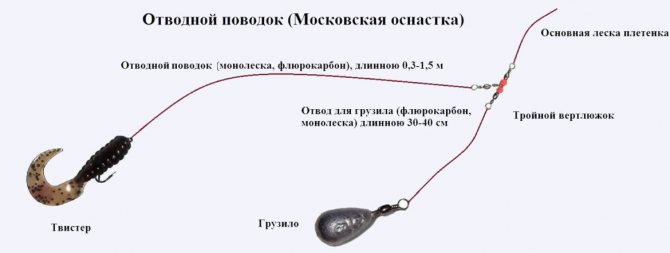
The color range of silicone baits is very extensive. Definitely, the assortment should have natural colors - light belly and dark back. Sometimes, in the most hopeless moments, poisonous colors come into play. Color designs using sparkles are widely popular; such baits have a defiant effect on predators. In addition to the legendary silicones listed above, examples of catchy silicone lures for pike in the fall are lucky john, Fanatik, Bait Breath, Keitech.
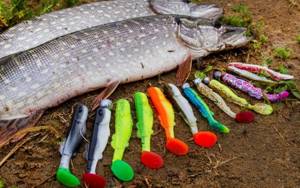
Foam rubber bait is used very rarely when fishing for pike. To a greater extent, foam rubber is intended for catching pike perch. However, for jigging, dragging or demolition, a foam fish is better suited. And when all the techniques and baits have been tried, then it also makes sense to try foam rubber dragging.
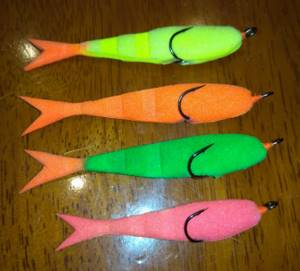
Spinner is a classic bait with half a century of age. Oscillating and front-loaded rotating versions of spinners are suitable for jig fishing.
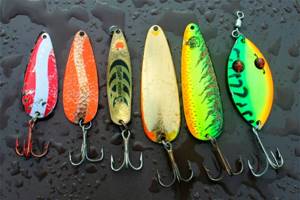
As a rule, spinners are used on reservoirs with a clean bottom, because even slight vegetation and a small number of shells will appear almost immediately. Watch the video: The best silicone lures for catching pike in the fall
Despite the fact that fishermen often prefer silicone baits, spinners are a must-have in your assortment, since there are times when it is the spinners that shoot. There are world-famous brands of spinners that are hard for pike to resist. Such oscillators include ACME, Kuusamo, Mepps. Watch the video: How to properly rig jig baits
How to catch pike with a jig
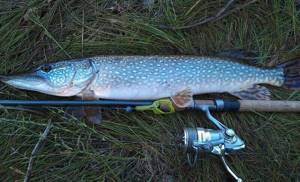
You can catch pike with a jig in various reservoirs; the only inconveniences to fishing are dense aquatic vegetation and silty bottom sediments, which do not allow the equipment to work properly. As a rule, jigs are used to fish hard bottom bases at the boundaries of aquatic vegetation, edges and dumps at the transitions to different depth levels, driftwood and dead wood. Promising points are considered to be places near hydrological structures and bridges, as well as stuck areas of water areas. The depth factor has little effect on fishing possibilities, which are equally successful both at meter and 10 meter marks.
Postings
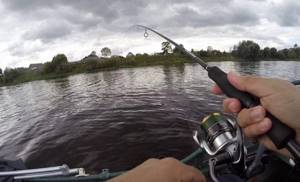
During the cultivation of this type of fishing, jig wiring has acquired a number of distinct directions, which are considered basic in jig technology. Based on these techniques, spinning anglers, adding certain technical techniques to them, such as pauses, jerk length and bait toss height, practice their own jigging technique. We will present to the reader fundamental methods of posting that will help to understand the principles of jig fishing.
American way
The wiring technique is based on the animation of the bait using a fishing rod. After casting, the jig head is allowed to sink to the bottom and two or three pulls of 15–20 cm each are made with the spinning rod, and during a subsequent pause, reeling out the slack line. Thus, the equipment is carried out along the selected trajectory, selecting the length of the pauses and the magnitude of the pulls depending on the bites.
Step view
This method is based on animation of the bait with a reel. After the rig touches the bottom, the reel is made two or three full turns, alternating such winding of the cord with a pause. During the pause, the bait, raised from the bottom and making a step at each turn of the reel handle, falls to the bottom again. As in the previous case, by increasing the pause time, the optimal wiring rhythm is selected.
Aggressive wiring method
This technique is used in the complete absence of bites, when you need to force the predator to pay attention to the installation by sharply moving the equipment. The wiring style is similar to twitching. The bait is torn from the bottom with a sharp jerk of the rod; this is achieved by lifting the quiver tip of the tackle upward, throwing it 20–30 cm in the water column. After a pause, the spinning rod is returned to a horizontal position, while simultaneously reeling out the slack cord. The jig bait for pike acts with sharpness of movement and is attacked during a pause, after the first couple of jerks.
Carrying out demolition equipment
The demolition technique is carried out according to the principle of the American method of fishing, only fishing is carried out on the current. During the pause between pulls, the bait lifted from the bottom by the force of the current is carried along its course, and the excess cord is wound onto the spool of the reel. During demolitions, such silicones as twisters and worms perform well, the natural movement of which due to the forces of the current does not go unnoticed by the toothy one.
Uniform type of wiring
The most technically complex type of fishing, requiring the angler to strictly control the bait in the water column. Various water horizons are fished using this method. After casting, the bait is not placed on the bottom, but having reached a certain level, they begin a uniform reeling, during which a pause is made, moving the bait to a lower level, and when reeling begins, returning to the initial horizon. Thus, the installation makes wave-like movements in the water column. Otherwise, this technique is called pelagic jig.
Successful "foam rubbers"
Sometimes all baits are inferior in effectiveness to the cheapest and most active foam fish, which have a surprisingly nimble and fast game. In addition to the classic game during retrieving, they have the ability to provoke a predator even during a pause, when a flat sinker, having fallen edge-on to the bottom, begins to fall flat. During this short movement, the “foam rubber” also makes a short, but very attractive to the predator, fidgeting movement, which the most well-fed and lazy pike cannot endure. And she will definitely attack this impudent and fussy “fish”, if only the “foam rubber” comes into her area of attention.
Share with your friends!
Features of fishing at different times of the year
The jig fishing method undoubtedly differs depending on the season of the year. These changes affect both the behavior of the predator and the processes in changing the structure of the reservoir itself. For example, pike are more willing to jig in the fall than in the summer due to their increased feeding activity, and even in the autumn months, dormant aquatic vegetation opens up new points for comfortable fishing. We will discuss the nuances of spinning hunting in different seasons of the year in continuation of the jig theme.
Spring
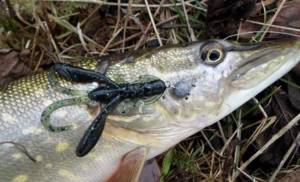
They begin jigging already with the first melting of the ice cover, fishing for exits to the shallows in the coastal zones of the reservoir and riffles at the places where smaller tributaries with fresh water flow into rivers and lakes. In muddy waters, light-colored baits are used, making monotonous and non-aggressive retrieves. Peak fishing occurs during the pre-spawning period in March or April, which depends on the geographic location of the region. According to the observations of anglers in the spring, the bite is better in the afternoon, towards evening, although the fish become active in the morning, with full sunrise.
Summer
Summer is not the most productive time for jigging. The pike disperses throughout the reservoir, taking up positions in thickened areas of water areas where jig fishing becomes impossible. In the summer months, fishing is promising at the boundaries of clear water and thickets, in snags, as well as on river beds along the edges of holes and on rifts. Lures are used in medium sizes, using natural colors. Pike bite better in the early morning and evening hours, resting throughout the rest of the day.
Pike jigging in autumn
Catching pike with a jig in the fall is the most promising. The predator is noticeably more active, and water bodies are freed from algae and become more suitable for fishing than ever before. Since the beginning of the autumn season, they have been fishing in relatively shallow waters, moving with cold weather closer to the deeper parts of the water areas. The speed of the posting increases, as does their aggressiveness, and the largest silicone and foam fish are used as bait in the hope of catching large specimens. Jig hunting is carried out right up to freeze-up, throughout the daylight hours.

